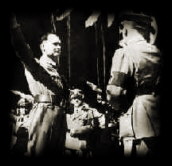






Rudolf Hess was born in
1894 in Alexandria, Egypt, the son of a German merchant. During
the First World War he served in the German Army and was
seriously injured at Verdun in August 1917. In the same year he
got promoted to Lieutenant and voluteered for the flying corps.
From autumn 1918 onwards he fought in the fighter squardon 35 at the western front. After the end of the war he became a volunteer in the "Freikorps von Epp", a right wing paramilitary formation during the Weimar Republic. In June 1920 he joined the NSDAP and took part in the unsuccessful coup de etat on 9th November 1923 in Munich, which had the aim to overthrow the Bavarian government. Together with Adolf Hitler he was imprisoned at Landsberg. On his release from prison he became Hitler's private secretary and accompanied him on most of his political travels throughout Germany. When the Nazis came into power, in 1933, he was elevated to the rank of a minister and became a member of Hitler's cabinet and at the same time became Hitler's dedicated deputy.


Rudolf Hess and Hitler
In a famous speech he praised his Führer:"Do not seek Adolf Hitler with your mind. You will find him through he strength of your hearts! Adolf Hitler is Germany and Germany is Adolf Hitler. He who takes an oath to Hitler takes an oath to Germany!"
During those hectic days of January 1933, Rudolf Hess never left Hitler's side. In a hand-written letter to his wife, dated January 31, 1933 - that is, the day after Hitler became Chancellor - the 38-year-old Rudolf Hess recorded his feelings during this moment of triumph:
Am I dreaming or am I awake - that is the question of the moment! I am sitting in the Chancellor's office in the Wilhelmsplatz. Senior civil servants approach noiselessly on soft carpets to submit documents "for the Reich Chancellor".... Outside, the public stands patiently, packed together and waiting for `him' to drive away - they start to sing the national anthem and shout "Heil" to the "Führer" ... and then I start to shake and I have to clench my teeth ...
In one of the most startling events of WWII Rudolf Hess made his famous solo airplane flight in a ME 110 to Scotland and arrived unexpectedly in May 1941. On landing he was immediately taken as a prisoner of war by the British, but he demanded to see the Marquess of Clydesdale, whom he said he had met at the 1936 Berlin Olympics. He claimed his mission was to seek a peace between Germany and Britain so that jointly they could wage war against the Soviet Union. Clydesdale had indeed attended the Olympics, but always claimed he had never met Hess, who by that time was becoming a marginal figure in the Third Reich; although because of personal loyalty based on their early joint struggles in the Nazi Party Hitler kept him in the public eye. Churchill refused to see Hess while the Nazis declared him mental unconscious ...


Rudolf Hess made a solo flight to Scotland
The official version of the Hess affair is that, on his own initiative, he took off from Augsburg bound for Scotland on a peace mission on May 10 1941. Running short of fuel and finding it difficult to land, he bailed out of his Messerschmitt 110D about 12 miles short of his destination - the estate of the Duke of Hamilton at Dungavel. The pilot first identified himself as Hauptmann Alfred Horn and said he wished to see the Duke of Hamilton. He later identified himself as Rudolf Hess.
Hess, the official version runs, had been under the delusion that the Duke of Hamilton and other prominent members of the British establishment would be willing to discuss peace terms with Germany, and that the common enemy was Bolshevism, particularly in the guise of Stalin's Soviet Union.
But no one knows for sure whether Rudolf Hess undertook his flight with the knowledge and blessing of Adolf Hitler. Both men are now dead. But available evidence, though, suggests that Hitler knew in advance of the flight.
Just a few days before his flight, Hess had a private meeting with Hitler that lasted four hours. It is known that the two men raised their voices during portions of their talk, and that when they were finished, Hitler accompanied his Deputy to the ante-room, put his arm soothingly around his shoulder, and said: "Hess, you really are stubborn." The relationship between Hitler and Hess was so close and intimate that one can logically assume that Hess would not have undertaken such an important step in the middle of a war without first informing Hitler.
Although Hess' adjutants and secretaries were imprisoned after the flight, Hitler intervened to protect Hess' family. He saw to it that a pension was paid to Hess' wife, and he sent a personal telegram of condolence to Hess' mother when her husband died in October 1941.
Gauleiter Ernst Bohle, the Hess confident and high-ranking official who had helped Rudolf Hess to translate some papers into English, remained convinced until his death that all this was done with Hitler's knowledge and approval.
Until the end of the war Rudolf Hess remained a prisoner and in 1946 he was convicted as a major war criminal during the war crimes trials which were held at Nürnberg. He was then sentenced to life imprisonment at Spandau Prison, West Berlin.
After the release of Albert Speer and Baldur von Schirach on October 1, 1966, Hess was the only prisoner until his suicide in 1987. So for more than twenty years, Hess was the sole prisoner in a prison designed for about six hundred.
For many years Rudolf Hess refused visits from members of his family but he changed his mind in November 1969, when he became severely ill and had to struggle to stay alive. He agreed to a visit by his wife Ilse Hess and the son Wolf Rüdiger in the British Military Hospital in Berlin. Thus, on December 24, 1969, they visited him for the first time ...
After being returned to the Allied Military Prison in Spandau, he agreed to further visits. In the years that followed, members of the family visited Rudolf Hess 232 times altogether. Only the closest members of his family were allowed to meet with him. It was forbidden to shake hands or embrace. Presents were also forbidden, even on birthdays or at Christmas.
|
Rudolf Hess at Spandau |
|
On Monday, August 17, 1987, a journalist informed the son that his father was dying. Later he received a telephone call at 6:35 p.m. from the American director of the Spandau Prison, who informed him officially that his father had died, aged 93.
The official notification, which was in English, read as follows: "I am authorized to inform you that your father expired today at 4:10 p.m. I am not authorized to give you any further details."

Adolf Hitler's SS Men Hitler surrounded himself with a small clique of fanatical, ruthless henchmen - a violent group of outsiders who rose to power in the Third Reich and established political and economic institutions of legitimized terror. These masterminds of death were found to be quite psychologically normal. They were men of fine standing, husbands who morning and night kissed their wives, fathers who tucked their children into bed. But murders, brutalities, cruelties, tortures, atrocities, and other inhuman acts were an everyday occurrence. The European Jews were the primary victims of the Nazis. In 1933 nine million Jews lived in the 21 countries of Europe that would be occupied by Germany during the war. By 1945 two out of every three European Jews had been killed. But Jews were not the only group singled out for persecution by Hitler's Nazi regime. One-half million Gypsies, 250,000 mentally or physically disabled persons, and more than three million Soviet prisoners-of-war also fell victim to Nazi genocide. Jehovah’s Witnesses, homosexuals, Social Democrats, Communists, partisans, trade unionists, and Polish intelligentsia were also victims of the hate and aggression carried out by the Nazis. |
|
|
![]()
source:
Who`s Who in Nazi
Germany - Robert S. Wistrich, Routledge,
The Life and Death of My Father, Rudolf
Hess by Wolf Rüdiger Hess
www.auschwitz.dk www.oskarschindler.com www.emilieschindler.com www.shoah.dk
© 2009-2011
Louis Bülow Privacy
All Rights Reserved.